- Home
- Terry Pratchett
The Folklore of Discworld Page 4
The Folklore of Discworld Read online
Page 4
Around the Godde there forms a Shelle of prayers and Ceremonies and Buildings and Priestes and Authority, until at Last the Godde Dies. Ande this maye notte be noticed. [Small Gods]
To make matters worse, Om-as-tortoise found his physical life in danger. Far too many people he met knew that ‘there’s good eating on one of those’. He was also being hunted by an eagle who had found out that if you carry off a tortoise in your talons and drop it on a rock from a great height, the result is a shattered shell and a rather fiddly meal. If, on the other hand, you drop it on somebody’s head, then you are recreating the Earth legend which claims that the Ancient Greek dramatist Aeschylus was killed when a flying eagle dropped a tortoise on his bald head, mistaking it for a rock.
That eagles in some places have learned to drop tortoises in order to crack them open has been attested to by various sources, and our suspension of disbelief in a bird’s ability to target humans in the course of breaking its lunch was occasioned by a Daily Telegraph obituary of Brigadier John Mackenzie. In the Second World War he worked with partisans in the mountains of Greece, and ‘… on one occasion a brigade rifle meeting on a mountain was disrupted when a flock of vultures carrying various small tortoises in their talons decided to drop them on the mountainside to crack their shells. Two soldiers sustained fractured skulls from the tortoises and there were other injuries; the meeting was abandoned.’
Om has been affected by his spell as a humble tortoise. The Omnian Church has now disbanded its Quisition. Divine smitings have become noticeably rare. Om’s devotees grudgingly allow foreigners to worship their own deities without being massacred, and his missionaries simply afflict the infidel with hymns and excruciatingly boring tracts. Clearly, this is all made up and the story has nothing to do with any ‘Earthly’ deity.
Valkyries
Valkyries form a group of very specialized goddesses honoured by Barbarian Heroes; their name means ‘Choosers of the Slain’. They are found both on the Discworld and in the Nordic and Germanic myths of Earth, where they serve Odin the God of War (also known as Wotan or Woden). They became even better known through a nineteenth-century opera by the German composer Wagner. They are tall, powerfully built women, wearing chain mail and horned helmets, and riding magnificent airborne horses. Since Wagner’s time, a good singing voice is also a requirement for the job, for they ride to a rousing chorus of ‘Hi-jo-to! Ho! Hi-jo-to! Ho!’
The task of a Valkyrie is to hover over battlefields where her chosen Hero is fighting, bringing him good luck for as long as the God of War decrees. Then, when the fated time comes for the Hero to be killed, she swoops down and carries his soul to Odin’s Valhalla, ‘Hall of the Slain’ – or to its Discworld equivalent, the Halls of Blind Io – where he will enjoy a blissful afterlife of quaffing mead and feasting on roast boar. The Valkyries will be on hand to make sure the drinking horns are kept filled. And there is other fun to be had too, as the medieval Icelandic writer Snorri Sturluson explained in his account of heathen Nordic mythology, The Edda, in the 1220s:
‘What sport is there for the Chosen Warriors when they aren’t drinking?’ asked Gangleri the Wanderer.
The High One said: ‘Every day, when they have dressed they put on their armour and go out into the open country and have a battle, and they kill one another, every one of them. That is their sport. And when the time for the evening meal comes round, they ride back home to Valhalla and sit down together to drink again.’
It’s a magnificent option, an offer one can’t refuse. But sometimes, sometimes – well, maybe only once in all the centuries of the Discworld, and never on Earth – there come Heroes like Cohen the Barbarian and his Silver Horde, who do refuse it, as is told in The Last Hero. As their confederate Mr Saveloy had once pointed out (in Interesting Times), it does sound like spending forever in a room full of sports masters. And it involves hobnobbing with gods, which isn’t to everyone’s taste. Instead, Cohen and the Horde choose to ride away to the stars.
DEMONS OF THE NETHER PIT
Demons have existed on the Discworld for as long as the gods, whom in many ways they closely resemble. There are millions of them. They find it very galling that those stuck-up bastards in Dunmanifestin refuse to take them seriously.
The demons live in a spacious dimension which is more or less on the same space-time continuum as that of humans, and which they have tastefully decorated in shades of flame and keep heated to roasting point, as tradition requires. It is arranged in eight circles, surrounding a bubbling lake of lava-substitute, from which rise the majestic towers of Pandemonium, the Demon City. Demonic society is strongly hierarchical, murderously competitive, and devoted to tradition. Its higher ranks have added impressive titles to their sonorously supernatural names – Lord Astfgl, Duke Vassenego, Earl Beelzemoth, Duke Drazometh the Putrid. This, incidentally, is equally true on Earth, where the famous grimoire known as the Lemegeton, attributed to King Solomon, is intensely class-conscious. It lists seventy-six aristocratic demons: eighteen kings, twenty-six dukes, fifteen marquises, five earls and twelve presidents, besides various minor groups.
Demons take a lively interest in observing human affairs, partly out of curiosity and partly because they do so much admire human ingenuity when it comes to devising ways of hurting one another. Like the gods, they can peer across multidimensional space, and take note of events and ideas on the Earth as well as on the Disc. This is useful to them, since they are about as capable of original thought as a parrot is of original swearwords. Their Infernal Regions would have been pretty bleak without the picturesque notions they pinched from human imaginations. From the Bible they got the idea of a lake of fire, mentioned in the Apocalypse (Book of Revelation); from the medieval Italian poet Dante, the idea that Hell is a deep funnel-shaped pit, with circular terraces running round it – Dante talked of nine circles, but the Discworld demons opted for eight, the preferred magical number in their universe. In Milton’s Paradise Lost, it is said that devils built themselves a palace in Hell by the power of magic and music, and called it Pandemonium:
Anon out of the earth a fabric huge
Rose like an exhalation, with the sound
Of dulcet harmonies and voices sweet –
Built like a temple, where pilasters round
Were set, and Doric pillars overlaid
With golden architrave; nor did it lack
Cornice and frieze, with massive sculptures graven;
The roof was fretted gold …
And so on and so forth – brazen doors, marble pavements, starry lamps, a jewelled throne – the lot. But still, it was just one palace. The Discworld demons can do better than that: their Pandemonium is a whole city.
Most demons are rather old-fashioned as regards their personal appearance, liking to look as disgusting as possible. Thus Urglefloggah, Spawn of the Pit and Loathly Guardian of the Dread Portal, who welcomes newcomers to Hell, has various well-fanged mouths and more tentacles than legs, though fewer arms than heads. First impressions are so important. Then there was Quezovercoatl the Feathered Boa, a demon who went off to become a god to the humans of the Tezuman Empire and teach them how to cut the hearts out of one another on top of pyramids. It is thought that he had picked up his ideas from the Aztecs of Mexico, and likewise (more or less) his name. He was half-man, half-chicken, half-jaguar, half-scorpion, and half mad. However, he was also only six inches high, so when forced to manifest himself physically he came to a sad, squishy end.
At the time of the events described in Eric, Hell was ruled by a relatively new king named Astfgl, who was determined to modernize everything, including his own appearance. His predecessors had gone in for hoofs and shaggy hind legs, but such things were beneath him. Nor would he ever consider tentacles, or grotesque faces in unseemly places. Instead, he favoured a red silk cloak and gloves, crimson tights, a cowl with two rather sophisticated little horns on it, and a trident. A brief glance at the theatrical archives of Britain had been enough to show him that this i
s the correct formal dress for a Demon King. Regrettably, whenever he lost his temper his neat costume would get ripped apart in a sudden sprouting of claws and wings.
Lord Astfgl also revamped the whole infernal regime to conform to up-to-date business practices. He abolished good traditional tortures such as pushing a rock uphill only for it to roll down again, or having your liver eaten by an eagle every day – both copied from excellent models in Greek myth, the punishments of Sisyphus and Prometheus. Instead, he issued memos, policy statements, and morale-boosting notices to staff. In agonies of outrage and boredom, the lesser demons conferred on him the title of Supreme Life President of Hell and gave him a luxurious but remote office to himself, where he is still happily busy compiling an in-depth analysis of the role, function, priorities and goals of the demon race. After which, the old familiar flames flickered once again. It was for the best (or, technically, for this is Hell, for the worst). It is only a matter of time before he invents the first-ever mission statement, causing his world to end in self-defence.
It is a curious fact that demons, powerful though they are in their own dimension, can nevertheless be summoned into the human world and told to make themselves useful. In theory, this requires elaborate magic circles, runes, pentacles (on Earth) or octograms (on the Discworld), plus special robes, wands, knives, swords, candles, talismans, and incense, all of which come expensive. Then there are the chants and invocations, which go on and on and on. Part of a conjuration composed in the 1640s by the learned Elias Ashmole (antiquary, alchemist, astrologer, and founder of Oxford’s Ashmolean Museum) runs as follows:
I, Elias Ashmole, adjure thee Elaby Gathen, straightly charge and command thee by Tetragrammaton, Emmanuel, messias, sether, panton, cratons, Alpha and Omega, and by all other high and reverend names of Almighty God both effable and ineffable … that thou appear meekly and mildly in this glasse, without doinge hurt or daunger unto me or any other living creature … and truly, without fraud, dissymulation or deceite, resolve and satisfye me in and of all manner of such questions and commands and demandes as I shall either aske, require, desire or demande of thee …
Demons love this kind of language. They think it shows proper respect. And so long as you are ceremonially robed and equipped, and chanting jargon by the bucket-load, they manage to forget that what’s actually going on is that they are being ordered about by a human.
They are less happy if someone cuts out the frills, as the three witches of Lancre did in an emergency. Being in Nanny Ogg’s washroom at the time, they used a sharp and terrible copper-stick, scattered some rather old washing soda and extremely hard soap flakes, and bound the demon by the names of the bald scrubbing brush of Art and the washboard of Protection. And if the Summoning was unorthodox, the Dismissal was frankly insulting:
‘May I go now?’
‘Um?’
‘Please?’
Granny jerked upright again.
‘Oh. Yes. Run along,’ she said distractedly. ‘Thank you.’
The head didn’t move …
‘You wouldn’t mind banishing me, would you?’ said the demon, when no one seemed to be taking the hint.
‘What?’ said Granny, who was thinking again.
‘Only I’d feel better for being properly banished. “Run along” lacks that certain something,’ said the head …
‘Certainly,’ said Magrat. ‘Right. Okay. Um. Begone, foul fiend, unto the blackest pit—’
The head smiled contentedly as the words rolled over it. This was more like it.
It melted back into the waters of the copper like candlewax under a flame. Its last contemptuous comment, almost lost in the swirl, was, ‘Run aaaalonggg …’ [Wyrd Sisters]
Finally it has to be said that on the Disc there are certain low-grade demons who stay permanently in the human world, working inside pocket watches, picture-making devices, personal disorganizers, and similar contraptions. Some are eager to please, others distinctly surly. The great lords of Hell never, ever, mention this.
THINGS FROM THE DUNGEON DIMENSIONS
It is well known on the Discworld that Things from the shadowy, chaotic wastelands outside space and time which some call the Dungeon Dimensions are always trying to break through into the little circle of candlelight loosely called ‘the real world’. They prowl round its flimsy stockades, searching for places where the fabric of reality has worn thin. Their shapes are unstable, but nasty, with random combinations of tentacles, talons, mandibles, spindly limbs, and wings; this reflects their sad, mad, incoherent minds. They hoot and howl and buzz, giggle and flutter, and produce a horrible chittering sound. Any large concentration of magic attracts them. They crave the solidity, light, and life of real worlds, and hate all living creatures with a deep and jealous hate; if they did gain a foothold on the Disc they would inevitably drain all life from it. Occasionally some deluded power-seeking magician imagines that he can safely invoke and control them – or manages to trap the even more mysterious parasitic entity known as the hiver, described in A Hatful of Sky. This brings disaster on the magician himself, and on others. More often, someone accidentally creates a point of entry by, for example, conducting a powerful magical or religious ceremony at a spot where the walls between the dimensions are already weak. So far, the breaches in the walls have always been healed and the Things repulsed before too much harm has been done.
It appears from the obscure writings of some exceptionally erudite wizards that the Things were once Dark Gods, existing on the Discworld until they were driven out by even more ancient and powerful beings, the Old High Ones. Their names are listed in the utterly forbidden and totally perilous grimoire known as the Necrotelicomnicon or Liber Paginarum Fulvarum (Book of Yellow Pages) compiled by the Klatchian necromancer Achmed the Mad. The first edition of this dread opus is kept in conditions of maximum security in the vaults of Unseen University, and students are only permitted to read tenth- or twelfth-hand copies.
Awareness of these occult matters first reached the Earth through the receptive mind of the American writer H. P. Lovecraft, creator of horror fantasies in the 1920s and 30s. He too described monstrous beings from other dimensions forever trying to break through into the normal world; he too wrote of a potently evil book of spells written by a mad Arab, the Necronomicon, which could be used to summon and worship them. Alarmingly, it appears from his writings that these creatures have more than once managed to establish themselves in isolated parts of America. One can only hope he was mistaken, but sometimes one fears he was not.
BEL-SHAMHAROTH
It is hard to know how to classify this extremely unpleasant entity.
On the one hand, it could be argued that he should be considered a god, since he inhabits a black eight-sided temple deep in the forest of Skund, near the Hub. He lurks there under an eight-sided stone slab in a hall with eight walls, reached by eight corridors and lit by the dim, eldritch glow of eight-sided crystals. Whether he currently has any worshippers is a very moot point – those who built the temple died long ago, and people who enter it now have an extremely short life-span. However, the level of belief they experience during the few moments that they are face to face with Bel-Shamharoth is so exceptionally intense that it keeps him in existence. His appearance is totally non-humanoid. He looks rather like a spider, or maybe an octopus or squid, or maybe something altogether more strange; something black, at any rate, that is all suckers and tentacles and mandibles, with a single great glaring eye in the middle.
On the other hand, the gods of Cori Celesti have never accepted Bel-Shamharoth as one of their number. The Lady went so far as to say on one occasion that he should never have been spawned, and that she thought all such creatures had died out at the beginning of Time. This seems to imply that he was one of the Old Dark Gods that once existed on the Discworld, and that he managed to remain there when the others were driven out to the Dungeon Dimensions.
One of his powers, we are told in Equal Rites, is an ability to enter peopl
e’s dreams. Amazingly, this is so strong that he has been able to reveal something of himself even in another universe. His title of ‘Soul-Eater’ is echoed in the mythology of the Ancient Egyptians, who believed that when the dead entered the Afterlife their hearts were weighed against the Ostrich Feather of Truth. If they failed this test, they would be devoured by a hideous monster which crouched beside the scales, called the Eater of Souls. It did not, however, look like Bel-Shamharoth, simply being part lion, part crocodile, and part hippopotamus – no tentacles or suckers whatsoever.
Many centuries later, the image of a monstrous tentacular creature stamped itself deeply on the mind of H. P. Lovecraft. He described an incredibly ancient being named Cthulhu, one of the Old Ones who once ruled the Earth, now banished below the ocean bed, but still remembered and worshipped by some. A small stone figurine, of unfathomable antiquity, shows Cthulhu as ‘a monster of vaguely anthropoid outline, but with an octopus-like head whose face was a mass of feelers’. Even more appalling is the Dunwich monster, child of a human mother and Yog-Sothoth, another of the Old Ones; this creature is bigger than a barn, made of what looks like squirming ropes, ‘an octopus, centipede, spidery kind of thing’ with great bulging eyes all over it, and ten or twenty mouths all opening and shutting … Definitely an echo or emanation of Bel-Shamharoth.

 Feet of Clay
Feet of Clay The Color of Magic
The Color of Magic Thud!
Thud! Good Omens: The Nice and Accurate Prophecies of Agnes Nutter, Witch
Good Omens: The Nice and Accurate Prophecies of Agnes Nutter, Witch I Shall Wear Midnight
I Shall Wear Midnight Mort
Mort Raising Steam
Raising Steam Guards! Guards!
Guards! Guards!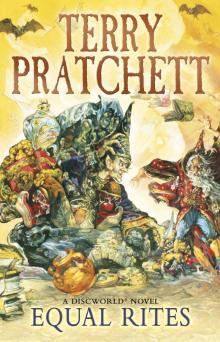 Equal Rites
Equal Rites A Hat Full of Sky
A Hat Full of Sky The Light Fantastic
The Light Fantastic Mrs Bradshaw's Handbook
Mrs Bradshaw's Handbook Wyrd Sisters
Wyrd Sisters Soul Music
Soul Music Small Gods
Small Gods Sourcery
Sourcery Reaper Man
Reaper Man Night Watch
Night Watch Lords and Ladies
Lords and Ladies The Fifth Elephant
The Fifth Elephant Monstrous Regiment
Monstrous Regiment The Truth
The Truth Witches Abroad
Witches Abroad Eric
Eric Going Postal
Going Postal Men at Arms
Men at Arms Jingo
Jingo The Amazing Maurice and His Educated Rodents
The Amazing Maurice and His Educated Rodents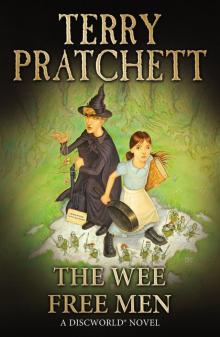 The Wee Free Men
The Wee Free Men Pyramids
Pyramids Wintersmith
Wintersmith Moving Pictures
Moving Pictures Carpe Jugulum
Carpe Jugulum Interesting Times
Interesting Times Maskerade
Maskerade Making Money
Making Money The Shepherd's Crown
The Shepherd's Crown Hogfather
Hogfather Troll Bridge
Troll Bridge The Last Continent
The Last Continent The Sea and Little Fishes
The Sea and Little Fishes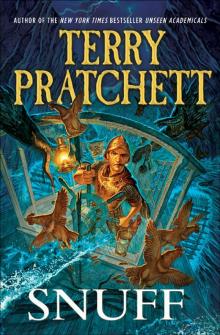 Snuff
Snuff Unseen Academicals
Unseen Academicals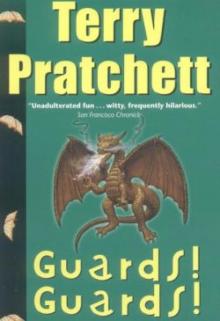 Guards! Guards! tds-8
Guards! Guards! tds-8 Jingo d-21
Jingo d-21 Turtle Recall: The Discworld Companion ... So Far
Turtle Recall: The Discworld Companion ... So Far The Fifth Elephant d-24
The Fifth Elephant d-24 Discworld 39 - Snuff
Discworld 39 - Snuff The Long War
The Long War Only You Can Save Mankind
Only You Can Save Mankind The Science of Discworld III - Darwin's Watch tsod-3
The Science of Discworld III - Darwin's Watch tsod-3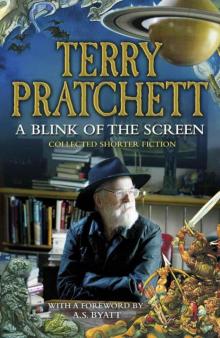 A Blink of the Screen: Collected Short Fiction
A Blink of the Screen: Collected Short Fiction Unseen Academicals d-37
Unseen Academicals d-37 Wings
Wings Making Money d-36
Making Money d-36 A Blink of the Screen
A Blink of the Screen Johnny and the Bomb
Johnny and the Bomb Dodger
Dodger Strata
Strata Discworld 02 - The Light Fantastic
Discworld 02 - The Light Fantastic The Folklore of Discworld
The Folklore of Discworld The Science of Discworld
The Science of Discworld The Unadulterated Cat
The Unadulterated Cat Raising Steam: (Discworld novel 40) (Discworld Novels)
Raising Steam: (Discworld novel 40) (Discworld Novels) The World of Poo
The World of Poo Discworld 05 - Sourcery
Discworld 05 - Sourcery The Witch's Vacuum Cleaner: And Other Stories
The Witch's Vacuum Cleaner: And Other Stories The Science of Discworld II - The Globe tsod-2
The Science of Discworld II - The Globe tsod-2 Small Gods: Discworld Novel, A
Small Gods: Discworld Novel, A Men at Arms tds-15
Men at Arms tds-15 Tama Princes of Mercury
Tama Princes of Mercury The Last Hero (the discworld series)
The Last Hero (the discworld series) The Long Utopia
The Long Utopia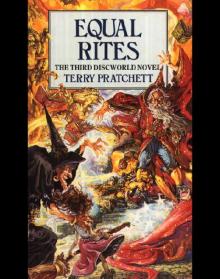 Discworld 03 - Equal Rites
Discworld 03 - Equal Rites Terry Pratchett - The Science of Discworld
Terry Pratchett - The Science of Discworld The Long Earth
The Long Earth The Carpet People
The Carpet People The Sea and Little Fishes (discworld)
The Sea and Little Fishes (discworld)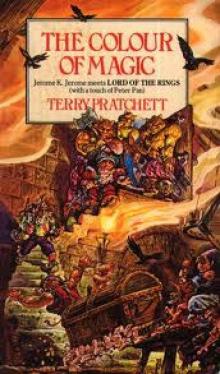 The Colour of Magic
The Colour of Magic Discworld 16 - Soul Music
Discworld 16 - Soul Music The Long Cosmos
The Long Cosmos The Dark Side of the Sun
The Dark Side of the Sun Monstrous Regiment tds-28
Monstrous Regiment tds-28 The Bromeliad 3 - Wings
The Bromeliad 3 - Wings Dragons at Crumbling Castle: And Other Stories
Dragons at Crumbling Castle: And Other Stories Night Watch tds-27
Night Watch tds-27 The Science of Discworld I tsod-1
The Science of Discworld I tsod-1 The Bromeliad 1 - Truckers
The Bromeliad 1 - Truckers The Science of Discworld Revised Edition
The Science of Discworld Revised Edition The Abominable Snowman
The Abominable Snowman Father Christmas’s Fake Beard
Father Christmas’s Fake Beard The Bromeliad Trilogy
The Bromeliad Trilogy A Slip of the Keyboard
A Slip of the Keyboard The Wee Free Men d(-2
The Wee Free Men d(-2 Johnny and the Dead
Johnny and the Dead Mrs Bradshaw's Handbook (Discworld Novels)
Mrs Bradshaw's Handbook (Discworld Novels) Truckers
Truckers The Amazing Maurice and His Educated Rodents d(-1
The Amazing Maurice and His Educated Rodents d(-1 Diggers
Diggers Thief of Time tds-26
Thief of Time tds-26 Science of Discworld III
Science of Discworld III Dragons at Crumbling Castle
Dragons at Crumbling Castle Nation
Nation Darwin's Watch
Darwin's Watch Interesting Times d-17
Interesting Times d-17 The Bromeliad 2 - Diggers
The Bromeliad 2 - Diggers The Science of Discworld II
The Science of Discworld II